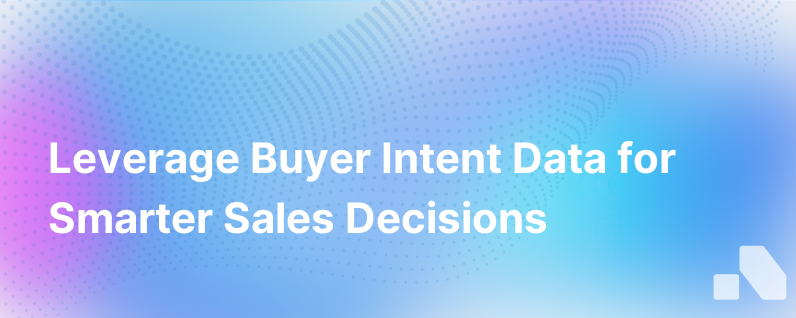
In the B2B world, understanding the buyer's intention can be likened to an intricate dance. It's about reading cues and anticipating the partner's next move. This is where buyer intent data steps in, revolutionizing the way companies approach potential customers. The barriers once presented by traditional guesswork are steadily dissolving with this emerging powerhouse of sales intelligence. Let's dive into how buyer intent data is transforming the sales landscape and why your business should be leveraging it.
Decoding Buyer Intent Data
Buyer intent data is the digital footprint that potential buyers leave behind during their online research. This data holds the key to their purchasing intentions. As marketers and sales professionals, capturing this data provides a lens through which you can view a prospect's current interests and future needs.
The idea of buyer intent is not new. Salespeople have always sought to understand a client's readiness to buy. However, with the advent of powerful AI and data analytics tools, capturing and interpreting this data has become more sophisticated and actionable.
Buyer intent data is gathered from various sources, such as website visits, content downloads, webinar sign-ups, search queries, product comparisons, and discussions on forums and social media. By analyzing this information, you can glean insights into what products or services a buyer is considering, when they might make a purchase, and what type of messaging might resonate best with them.
The Power of Buyer Intent Data for Your Business
Personalization and Buyer Intent Data
The necessity of personalized marketing cannot be overstated. With the amount of noise in the digital space, your message must hit the mark every time. Buyer intent data allows you to tailor your communications with precision. Instead of generic emails or ads, you can create custom content that addresses the prospect's specific pain points and positions your product as the solution they've been seeking.
Enhanced Lead Scoring
Traditionally, lead scoring has been based on demographic information and basic interactions like email opens or website visits. Buyer intent data adds a new dimension by factoring in the quality and frequency of these interactions. A prospect repeatedly searching for information on "enterprise cybersecurity solutions," for instance, is likely a more qualified lead for a SaaS cybersecurity firm than someone who's made a single visit to their blog.
Predictive Analytics & Sales Forecasting
Navigating through the murky waters of sales forecasting becomes less daunting with buyer intent data. Predictive analytics leverages this data to forecast future buying behaviors with increasing accuracy. You can prioritize your pipeline, align sales and marketing resources, and adjust your strategies to the evolving market realities.
Reduced Sales Cycles
Long sales cycles are a persistent pain in B2B sales. Buyer intent data accelerates the process by identifying prospects who are already lower in the sales funnel having exhibited strong buying signals. You spend less time nurturing uninterested parties and more time closing deals with those who are primed to buy.
Competitive Advantage
Perhaps most intriguing is the strategic edge that buyer intent data provides; you can see not only when companies enter the buyer's journey but also when they are considering your competitors. Armed with this intelligence, you can craft compelling counter-arguments, highlight your product's unique benefits, and reach out at just the right moment.
Gathering and Using Buyer Intent Data Effectively
There are a myriad of tools available today that collect buyer intent data, such as Demandbase, Bombora, and G2. These platforms track online behavior across websites and platforms to signal when a potential buyer shows interest in topics relevant to your offerings.
One approach to leveraging buyer intent data effectively is to integrate it into your CRM system, enabling a smoother transition from data to action. With buyer intent data at their fingertips, your sales and marketing teams can engage in highly focused, meaningful conversations with prospects who have a demonstrated interest in your products or services.
It's crucial to first ensure all teams are trained in interpreting and using the data. Misunderstanding or misusing buyer intent information can be as ineffective as not using it at all.
Ethical Considerations and Best Practices
As with any data-centric strategy, ethics play a pivotal role. Complying with privacy laws and regulations like GDPR and CCPA is non-negotiable. Be transparent in your data collection and usage, provide clear opt-outs, and protect the data from misuse.
Here are some best practices for using buyer intent data:
- Relevancy Is Key: Always create communication strategies that are highly relevant to the intent signals you're observing.
- Timing and Cadence: Learn the art of timing your outreach. Too soon and you might spook a potential buyer; too late and you might miss the window of opportunity.
- Continuous Learning and Training: Train your team on an ongoing basis. The landscape of digital signals and data interpretation is continuously evolving.
- Integration into Omnichannel Strategies: Leverage intent data across various channels for a cohesive strategy that nurtures leads effectively through the sales funnel.
Final Thoughts
In an increasingly digital world where data is abundant, harnessing the power of buyer intent data is essential for sales efficiency and effectiveness. The businesses that can capably interpret and act upon buyer intent signals will be those leading the charge in the marketplace. With a scientific approach to understanding buyer behavior, your business can realize reduced sales cycles, enhanced targeting, personalized outreach, and ultimately, increased revenue.
As you look ahead, consider how a platform like Aomni can seamlessly integrate buyer intent data into your sales strategy, empowering your reps to not just meet but exceed their targets with data-backed precision.